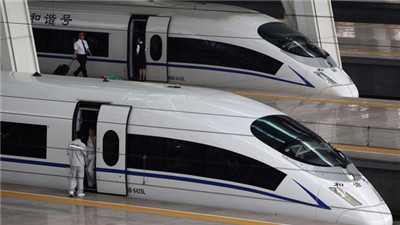(单词翻译:单击)
Ayear ago today, a lucky investor could have bought the Hong Kong-traded shares of China CNR and CSR Corp, then the country’s two dominant train makers, for less than HK$6.10 each and watched them rise and rise on rumours of an impending merger.
一年前的今天,一位幸运的投资者可能以每股不到6.1港元的价格买入了在香港上市的中国北车(CNR)和中国南车(CSR)的股票,然后伴随着合并传闻的发酵,看着股价一涨再涨。合并之前的中国北车和中国南车是中国两家占主导地位的列车生产商。

Six months later, the two companies confirmed that they would indeed become one, with CSR offering 1.1 shares — by then worth HK$8.05 — for every CNR share. When the new company, renamed CRRC Corp, began trading on June 8, its shares flirted with HK$15.70 before falling back during the past week. Barclays analysts have a price target of HK$17 for the new stock.
6个多月后,这两家公司证实了它们真的将合为一家,中国南车将以换股的形式合并中国北车,每1股中国北车股票换取1.1股中国南车股票(1.1股中国南车H股当时价值8.05港元)。合并后的新公司更名为中国中车(CRRC Corp)。当中国中车6月8日复牌时,其股价一度攀上每股15.70港元,过去一周里又跌了回来。巴克莱(Barclays)分析师给出的中国中车股票目标价为每股17港元。
Between them, these two lumbering rolling stock manufacturers have more than 170,000 employees and dozens of disparate subsidiaries spread across the country. Why are so many investors rushing to get aboard?
这两家“笨重”的铁路车辆制造商,在全国合计拥有逾17万名雇员,以及数十家五花八门的子公司。为何这么多投资者要抢着“搭车”呢?
It helps that CNR and CSR decided to hitch their wagons together during an unprecedented bull run for China’s equity markets. It was spurred to new heights by the launch of the Shanghai-Hong Kong Stock Connect scheme just as the two companies’ merger plans were finalised. The Connect programme allowed investors to move money between two bourses that were previously separated by China’s closed capital account.
在中国股市前所未有的牛市行情中,中国北车和中国南车决定把它们的车辆钩连在一起,这个时机选择得不错。就在两家公司合并计划最终敲定前夕,沪港通(Shanghai-Hong Kong Stock Connect)机制启动,股价因此被推上新高。沪港通允许沪港两地的投资者购买在对方交易所上市的股票,连通了此前被中国封闭的资本账户分割开来的两地股市。
But like all well-marketed mergers, this one has also sold investors on a larger story about an apparent new phase in the country’s much delayed state sector reform programme.
但是,就像所有推介得不错的合并案一样,南北车合并向投资者兜售了一个更宏大的故事,它讲述的是中国拖延已久的国企改革计划似乎将步入新阶段。
As with so many of China’s modern corporate champions, CNR and CSR have their origins in a common bureaucratic ancestor — a railways ministry that in its Maoist heyday built and operated every aspect of the industry.
正如中国当前许多领军企业一样,中国北车和中国南车都脱胎于同一个官僚机构——铁道部。铁道部的鼎盛时期在毛泽东时代,那时它负责铁路行业方方面面的建设和管理。
During the Chinese government’s first serious effort to reform the state sector — driven in the late 1990s by Zhu Rongji, then premier — the emphasis was on competition at home.
20世纪90年代末,在时任中国总理的朱镕基的推动下,中国政府第一次真正努力改革国有行业。那时改革的重点在于促进国内竞争。
Across entire industries, operating entities were separated from suppliers. CNR and CSR inherited, respectively, the rail ministry’s northern and southern rolling stock factories and were pitted against each other. Finally, the newly created companies’ profitable units were carved out and listed on Hong Kong’s stock exchange.
在各个行业,经营实体与供应商被分离开来。中国北车和中国南车当时分别继承了铁道部在北方和南方的铁路车辆工厂,相互间展开竞争。最终,这两家新创立的公司的盈利部门被剥离出来、在港交所上市。
As China’s economy soared after its turn-of-the-century entry into the World Trade Organisation, so did the profits of state organisations such as CNR and CSR. They had the support of state banks and a mandate to supply a globally unprecedented spending spree on high-speed rail and urban subway projects.
中国在世纪之交加入世贸组织(WTO)后,经济实现了迅猛增长,中国北车和中国南车等国企的利润也飞速增加。它们得到国有银行的扶持,并在一场全球范围内史无前例的高铁与城市地铁项目投资热潮中承担了供货任务。
In less than five years, China built the world’s largest high-speed rail network, its rolling stock supplied almost exclusively by CNR and CSR. As the government’s focus turns to urban rail projects, the now combined companies will supply nine out of every 10 new metro trains bought by subway operators across the country.
不到5年,中国就建成了世界最庞大的高速铁路网,上面行驶的列车几乎全都是由中国北车和中国南车供应的。眼下中国政府的重点转向城市轨道项目,未来全国各地地铁运营商新购买的地铁列车,有十分之九将出自合并后的中国中车。
The only problem was that a strategy that had worked so well at home was failing abroad, even though the two companies were by far the lowest bidders in many international tenders. They could offer a set of high-speed trains for less than two-thirds of the price charged by competitors such as Siemens.
唯一的问题是,一种过去在国内一直奏效的策略在国外却失灵了,尽管在许多国际招标中这两家公司给出的报价都远远低于竞争对手——它们供应一组高速列车的报价可比西门子(Siemens)等竞争对手低出三分之一以上。
The outcomes of their competing bids were often wildly erratic. Last October CNR won a contract to supply Boston’s subway system with more than 280 cars for $570m — compared with a $1bn bid by Bombardier — while CSR’s tender was rejected as “unacceptable” on quality and technology grounds. But CSR was a member of a Chinese consortium that successfully bid for a high-speed rail contract in Mexico, although the project was subsequently cancelled because of Mexican government budget constraints.
南北车在投标时相互竞争,往往导致非常离奇的结果。去年10月,中国北车赢得一项合同,以5.7亿美元的价格为波士顿地铁系统供应逾280辆列车。庞巴迪(Bombardier)的报价为10亿美元。中国南车的投标则因在质量与技术方面“不可接受”而被拒绝。但是,中国南车与其他中国企业组成的一个联合体曾中标墨西哥一个高铁项目,不过后来墨西哥政府因预算紧张取消了该项目。
As a combined entity with annual revenues of $32bn, CNR and CSR will no longer undercut each other and should be able to realise savings on functions such as research and development. But in other respects it will be a socialist merger with Chinese characteristics. Both companies have been coy about any cuts in their massive workforces.
南北车合并后年营收达320亿美元,它们将不再相互杀价,并且应该能在研发等职能方面节约成本。但从其他方面看,这将是一次有中国特色的社会主义合并。两家公司都不愿裁剪自己庞大的员工队伍。
In February an official at China’s state assets administrator said there would be no lay-offs in order to “guarantee stability for workers and the companies during the merger process”, suggesting that the merger is more about securing export orders abroad than advancing real corporate reform at home.
今年2月,中国国资委一名官员表示,为了“确保合并过程中员工和企业稳定”,合并后的中国中车不会进行任何形式的裁员。这表明,此次合并更多是为了在国外获得订单,而不是为了在国内推进实打实的企业改革。


